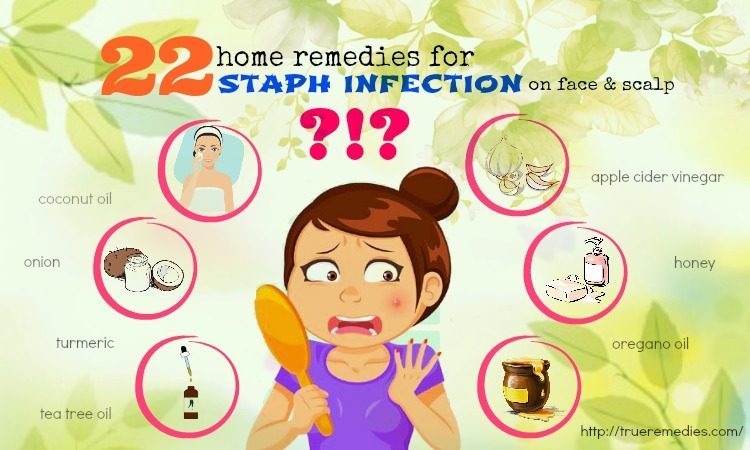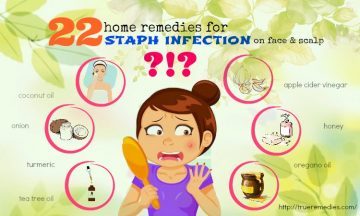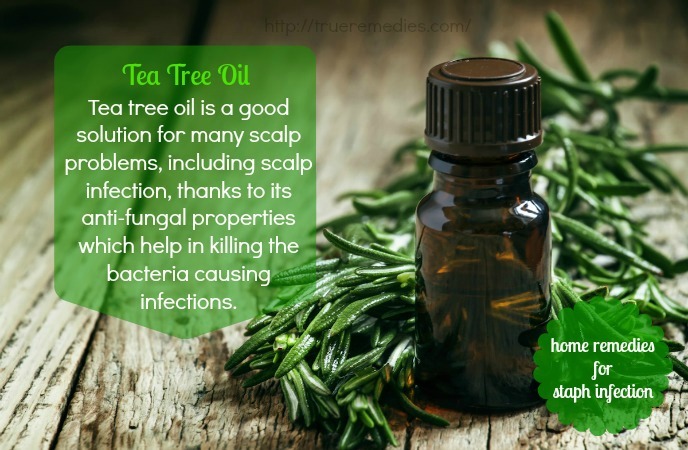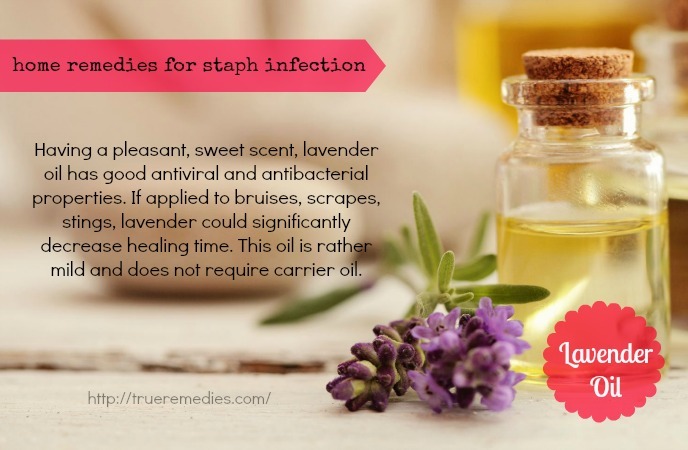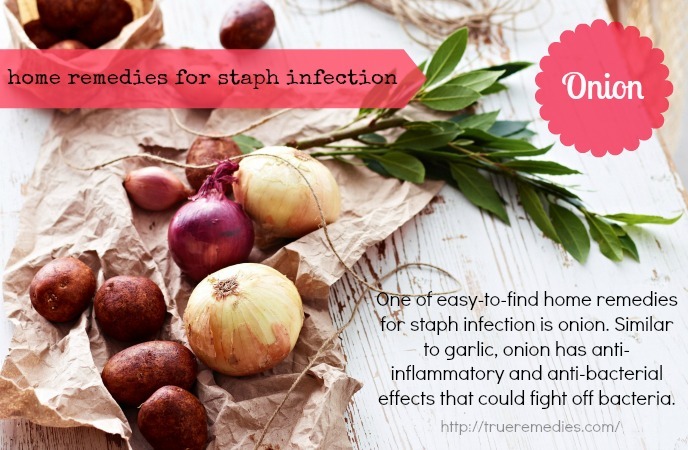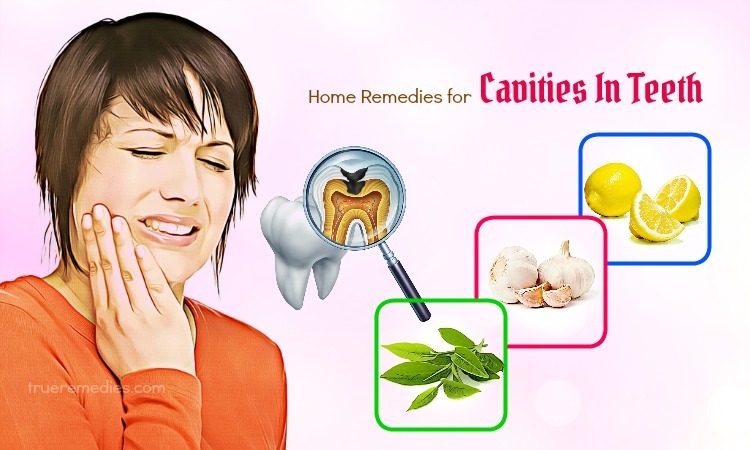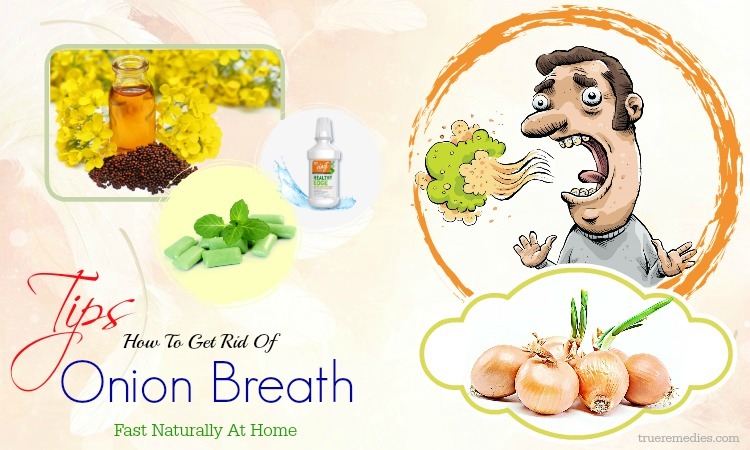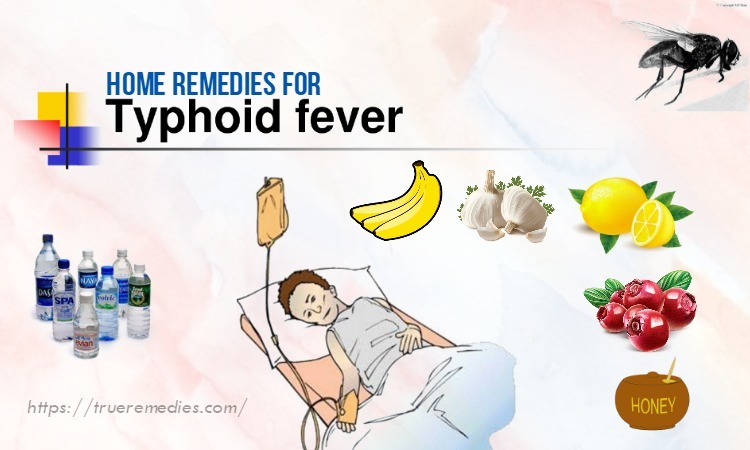updated: 08/27/2019
Contents
Staph infections, also known as “Staphylococcus Aureus,” or staphylococcus infection are a skin infection spreading from one person to another. This condition accounts for approximately 20% of the hospital visits related to annual infections. The mane of the bacteria causing staph infections is staphylococcus, which is common and exists on the skin of about 30% of even healthy population. To understand more about staph infection and home remedies for staph infection on face and scalp, read on the following article onTrueRemedies.com!
- Top 10 natural remedies for bacterial infection
- Top 25 home remedies for angular cheilitis infection
What Is A Staph Infection?
Most of the time, staphylococcus does not cause any problem or lead to relatively minor skin infections. However, staph infections could become deadly if the bacteria invade much deeper into the human body, entering your joints, bloodstream, lungs or heart.
Treatment often involves using antibiotics and drainage of the affected area. Nonetheless, some staph infections do not respond to common antibiotics.
What Are Causes Of Staph Infections?
Many people have staph bacteria but never develop staph infections. However, if you get a staph infection, chances are it is from the bacteria you have been carrying around for a certain amount of time. These bacteria could be transmitted from one person to another. As staph bacteria are hardy, they could live on inanimate objects like towels or pillowcases long enough to transfer to the next individual touching them.
Some ways the staph bacteria causes a staph infection:
TrueRemedies Partner Solutions

Need a Help from the Leading Expert Online, Available 24/7?
They’re all here and ready to answer your questions online or by phone. Keep asking questions until you get the answer you need.
- The MRSA bacteria might lead to many contagious skin infections as well as cellulitis. They are transmitted from an affected person to another.
- Poor hygiene also leads to a staph infection
- A weak immune system could make an individual prone to frequent bacterial infection
Who Is At Risk Of A Staph Infection?
Any person could develop a staph infection, but some individuals are more prone to this condition than others. Those people who are at higher risk of staph infections include:
- Infants and children, who might develop an infection known as “school sores” – impetigo, when they attend preschool or school
- People with a weakened immune system, like people with HIV/AIDS or people taking medications that weaken their immune system
- People who require medical equipment because of kidney dialysis, tube feeding, catheters, or breathing tubes.
- People who remain in the hospital for a long period of time and come in contact with other sick people and healthcare workers.
When To See A Doctor?
If you or your loved ones have the following signs, go to the doctor:
- Painful, irritated, or red skin
- Fever
- Pus-filled blisters
Also, you may want to consult your doctor if:
- Skin infections are being passed from one person to another
- Two or more members in a family have skin infections concurrently
What Are Symptoms Of A Staph Infection?
Some common staph infection symptoms that impact the skin could include:
- Developing an abscess causing swelling, redness, and pain. These could be seen in the form of visible boils, infected hair follicles, or bumps looking like cystic acne pimples. A lot of people developing a staph infection of the skin have a visibly swollen pocket which has pus and feels pain and tender if touched.
- Painful rash: some types of rashes may be caused by staph infections. One such rash is named impetigo – a type of skin rash which is contagious and results in large blisters. Blisters could sometimes build up crust coatings or open up and have fluid released. Another type of rash is cellulitis – a condition caused by an infection deeper beneath the skin surface. Cellulitis happens most often on the feet and legs and could result in patches of visible ulcers which ooze open.
- In babies or infants, a kind of staph infection named staphylococcal scalded skin syndrome could result in a blister or rash which exposes the raw skin. Some even develop fever symptoms concurrently.
Top 22 Home Remedies For Staph Infection On Face And Scalp
The recipes we've focused on are traditional home remedies, so always consult your doctor and check out your health condition regularly.
1. Tea Tree Oil
This is an essential oil which is famous for its versatile uses in health, beauty, and household. Tea tree oil is a good solution for many scalp problems, including scalp infection, thanks to its antifungal properties which help in killing the bacteria causing infections. Also, tea tree oil has terpinen-4-ol with antifungal and antibacterial properties that are good for treating scalp problems. Moreover, tea tree oil also has anti-inflammatory and antibacterial properties which may help in treating itchy scalp[1]. You can also use tea tree oil to moisturize the scalp as well as hair. Thus, it is one of the best home remedies for staph infection and itchy scalp. To make use of tea tree oil for scalp treatment, including scalp infection, you should follow these steps:
Method 1: Tea tree oil with a type of carrier oil
- Take a small bottle to fill it with ¾ full of carrier oil such as olive oil, jojoba oil, almond oil, etc.
- Then, add 10 to 15 drops of tea tree oil into the bottle and mix them well
- Apply the mixture over your hair and scalp
- Massage gently for several minutes to make the oil absorbed through the scalp. Doing so will create a tingling sensation on the scalp, but it will disappear soon.
- Wash the hair with your daily shampoo and followed by a conditioner
By applying this method, you can keep staph infections at bay.
Method 2: Tea tree oil and eucalyptus essential oil
- Mix a few drops of tea tree oil and eucalyptus oil together
- Warm the oil mixture and apply it over your scalp
Or, you can mix the oils with your shampoo and wash your hair with this mixture.
Method 3: Tea tree oil only
- Simply pour 5-10 drops of tea tree oil in the water
- Mix them well and use the mixture to rinse your hair
- Shampoo the hair, wash it with water carefully
Caution: Do not consume tea tree oil because it may cause side effects.
2. Manuka Honey
Manuka honey has been used traditionally to treat some conditions, such as infected wounds, ulcers, and certain hospital-acquired infections[2]. According to a study published in November 2002 of the “Journal of Applied Microbiology, manuka honey has the phytochemicals which play a main role in inhibiting the development of MRSA in the laboratory.
What you need to do is:
Apply Manuka honey over your infected area
- Leave it there for several hours prior to rinsing it off with water
- Repeat the routine several times per day till you get good results
Note: when buying manuka honey, you need to make sure it is a real one, with the necessary content of manuka in it.
Also, it is very important to heal your skin before the bacteria damages yourself from inside. Thus, it is advisable to take advantage of raw Manuka honey.
3. Apple Cider Vinegar
For centuries, we have used vinegar as a folk remedy for various illnesses. With the presence of malic acid – the substance known for having anti-inflammatory, anti-fungal, antiviral and antibiotic properties, apple cider vinegar is among effective home remedies for staph infection[3]. It may ward off the bacteria while promoting the healing process. Furthermore, it may boost your immune system to defeat and prevent further infection. What you need to do is:
Method 1:
- Mix raw, unfiltered apple cider vinegar with clean water with a ratio of 1:1.
- Use this solution to cleanse your wound 1-2 times per days for some days
Method 2:
- Or, you could also add 1-2 teaspoons of such type of apple cider vinegar to a glass of warm water.
- Add raw honey (optional) and mix them well
- Drink the mixture 2 times per day
Caution:
Although some people believe that the amino acids in this ingredient may act as an antibiotic which prevents the multiplying of bacteria, the use of apple cider vinegar to deal with infections might not be helpful. According to Katherine Zeratsky, a nutritionist in Mayo Clinic, apple cider vinegar might interact with some prescriptions or OTC medications you are using. For instance, if you use apple cider vinegar while taking insulin or diuretics could lead to potassium levels in the human body to drop too low. Low potassium or hypokalemia could cause muscle weakness, irregular heartbeat, and cramps. Severe hypokalemia could result in arrhythmias increasing your risk of stroke and heart failure.
4. Turmeric
Most staph infections are mild skin infections, however at times they can be severe enough to require a doctor’s attention. Turmeric is an effective herbal treatment for mild cases of staph infection. This orange-colored herb is widely used in cooking routines of Indian people and has been praised for centuries in Ayurveda as an anti-inflammatory and antiseptic agent[4]. Although many health food stores have turmeric capsules, the powdered form of this ingredient sold as a spice work well as well.
Turmeric also has plenty of manganese, vitamin B6, potassium, and iron which have antibacterial properties that may prevent bacterial conditions like MRSA (methicillin-resistant Staphylococcus aureus). To make use of turmeric for the staph infection, follow these steps:
- Mix 1 teaspoon of turmeric powder with 4-6 oz of warm water
- Consume the mixture with a meal or on an empty stomach
- Repeat this routine three times per day for 7 – 10 days.
Or, mix turmeric with milk with the ratio of 1:1 (or yogurt as well) and have that mixture. Curcumin in turmeric may work internally to ward off bacteria causing staph infections
You could also take turmeric supplements to prevent the recurrence of staph infections, but with the consultation of a doctor. There is no dosage for curcumin for a specific medical condition. The usual recommended dosage of turmeric is 1.5-3 grams cut turmeric root or 1-3 grams dried powdered turmeric root every day, 400-600 mg standardized powder thrice per day, or 30-90 drops of turmeric extract per day.
Caution:
- Drink plenty of water after using this ingredient because turmeric might cause dehydration.
- People with gallstones, heart failures, obstructive jaundice, toxic liver disorders or acute bilious colic should avoid using turmeric,
- Consult your doctor before using turmeric if you are getting pregnant or nursing or trying to get pregnant, or have a history of infertility issues, are under any kind of medication or have a blood-clotting disorder.
5. Garlic
Garlic not only adds flavor to pizzas and foods, but it also has tons of health benefits, such as allicin. Allicin, the active ingredient in garlic may help fight off fungal and bacterial infection, including the staph infection[5].
According to a study published in Medical News Today in 2003, allicin in garlic has immune-boosting properties which may give the health back to your body. Staph infection is spread via contact. If you develop a staph infection, there are a few ways you could make use of garlic to get rid of your problem:
Method 1:
- Consume 2-4 grams of fresh raw garlic each day. Choose the clove with the weight of about 1 gram
Method 2:
- Consume 600-1200 mg of aged garlic extract every day. According to the University of Maryland Medical Center, you should take 400mg at each meal for a sum of 1200mg.
Method 3:
- If you prefer liquid allicin supplements, consider taking supplements by taking advantage of 20ml of garlic oil. Add water to dilute the oil.
Method 4:
- Crush a clove of garlic. This will activate the allicin found in garlic.
- After 2 minutes, mash the clove.
- Then, apply the mashed garlic to your affected areas and use a bandage to cover it up.
- Change the bandage daily and replace the garlic with a fresh one when changing its dressing.
6. Oregano Oil
Oregano oil derives from the plant species Oregano vulgare that is usually confused with the kitchen oregano or oregano marjoram. True oregano oil includes chemical ingredients having carvacrol, terpenes, thymol, rosmarinic, and naringin. Those natural ingredients provide this oil the potential healing and antibacterial properties.
Oregano oil has antiviral, antiseptic, anti-parasitic, antioxidant and pain relieving properties[6]. This oil has been used for centuries for treating a lot of health issues, including the staph infection. The antimicrobial strength of this oil comes from its carvacrol and thymol content. The study conducted by researchers in the Journal of Medical Microbiology in 2007 proved that there was a positive effect of oregano oil on Staphylococcus and Staphylococcus epidermidis strains. What you need to do is:
Method 1:
- Dilute 8-10 drops of oregano oil in about 2 tablespoons your carrier oil, such as olive oil.
- Apply it over your infected area and wait for several hours prior to washing it off.
- Repeat this routine a few times per day
Method 2:
- You can add 5 drops of oregano oil with 1 glass of fruit juice or water and 1 tsp oil to decrease the caustic effects of the oil
- Drink the solution twice per day for about 1 week
Caution: Pregnant women should avoid using this type of oil.
7. Goldenseal
Goldenseal has multiple uses because of its wonderful ability to stimulate the immunity of our body. It also has powerful antibacterial and antiviral properties, so it is used to address some problems like upper respiratory infections, conjunctivitis, allergies, sinusitis, bacterial diarrhea, urinary tract infections[7]. Goldenseal is a natural supplement which is typically available as an extract taken from different parts of the plant, such as the seeds, leaves, stems, and root, or a raw powder. A study from the Peking Union Medical College in 2014 confirmed that goldenseal could reduce oxidation and inflammation accompanied by the staph infection and diabetes. What you have to do is
- Mix 1-2 teaspoons of goldenseal to 1 cup of hot water
- Let it steep for about 20 minutes and straining it up
- Use a cotton ball to apply the mixture over your infected skin area
- Repeat this routine twice or thrice per day for several weeks
Caution:
Goldenseal must be used with caution because it could stress the liver if taken too much for a long period of time. Consult your health professional before using this product.
8. Echinacea
For centuries, Echinacea has been used in the Native American folk medicines to treat this infection. The polysaccharides found in Echinacea may stimulate the immune system, strengthening the ability of the human body to ward off staph infection[8]. This herb also contains anti-inflammatory and antimicrobial properties which may ease the symptoms of staph infection and boost the recovery.
Try 1-2 grams of dried Echinacea for 3 times per day for 7-10 days to deal with the staph infection.
Or, you can also take echinacea supplements with the consultation of a doctor.
Caution: People with autoimmune disorders need to avoid this herb.
9. Eucalyptus Oil
Eucalyptus oil is a highly fragrant, milk and useful essential oil for infections. This multipurpose oil has anti-inflammatory, antiviral, and antimicrobial properties[9]. According to the famous British surgeon Joseph Lister, who is the father of modern antiseptics, the vapors of eucalyptus oil greatly decreased the deaths caused by infections. Eucalyptus oil has been found to help stimulate the immunity of the human body as well.
What you have to do is:
- Dilute several drops of eucalyptus oil in a few of carrier oil such as almond oil and olive oil.
- Apply the oil directly on wounds, skin infections and cuts and wait for several hours before washing it off
- Repeat twice per day for several days
10. Roman Chamomile Oil
This sweet-smelling and gentle essential oil is suited for those with sensitive skin and is commonly used to deal with mild to moderate acne. Roman chamomile could be used to handle diaper rash, eczema (atopic dermatitis) and other infections, including staph infection[10].
You just need to add several drops of Roman chamomile oil to your steam bath to help relieve the symptoms of staph infection. Roman chamomile has wonderful pain relieving properties.
11. Lavender Oil
Maybe, this is the most renowned oil in this list of home remedies for staph infection. Thanks to the pleasant, sweet scent, lavender oil has good antiviral and antibacterial properties. If applied to bruises, scrapes, stings, lavender may significantly decrease healing time. This oil is rather mild and does not require carrier oil. According to studies, lavender oil is effective in killing both gram-negative and gram-positive bacteria. In addition to being used for treating infections, lavender oil is also used to induce and improve sleep[11]. To make use of lavender oil for the staph infection, follow these steps:
- Apply Lavender oil directly on your affected skin
- Wait for 15 minutes to rinse it off with water
- Follow this routine twice per day for 1 week to get your desired results
12. Bitter Melon
Bitter melon has antiviral and anti-tumor actions that may help in treating infections. Bitter melon has a wide range of biologically active plant chemicals such as triterpenes, steroids, and proteins[12]. Bitter melon has been documented with antiviral properties against numerous viruses such as HIV viruses and the staph infection bacteria. It also strengthens the immune system to ward off staph infection.
- Slice 2 bitter melons and grind them off with a little water
- Squeeze out the juice of bitter melon and drink the solution on an empty stomach every morning.
Or, you can also apply this solution to your affected skin area.
13. Castor Oil
Castor oil, one of the most effective home remedies for staph infection, contains innumerable healing properties, in addition to its antibacterial as well as anti-inflammatory properties[13]. Thus, you should follow the instructions below:
- Warm a small amount of castor oil and apply it over your infected areas
- Use a warm cloth to cover it up
- Remove the cloth after a few hours
- Repeat this routine three times per day until you see results
The heat of the oil could dry the pus out and give you a natural relief from pain and swelling.
14. Fenugreek Seeds
The anti-inflammatory properties of fenugreek seeds could help in healing your wound caused by a staph infection. Additionally, they contain a large number of vitamins and minerals, proteins and amino acids which could give your immune system a boost[14]. Follow the instructions below:
- Soak a handful of fenugreek seeds in water for 3 hours
- Take them out to grind into a fine paste
- Apply the paste over your infected skin areas and wait for a few hours to wash it off
- Do this 1-2 times per day to get good results
To promote good recovery, you should consume the paste directly.
15. Nutmeg
Not only is nutmeg a common cooking ingredient, but it also has anti-bacterial and anti-inflammatory properties that could kill off bacteria causing staph infections as well as boils (Subcutaneous abscesses)[15]. Sufferers of staph infection could take nutmeg orally if used as an active ingredient in food to improve the immune system. The paste between nutmeg and water will help reduce bacteria and swelling around the wound. You could also apply nutmeg powder to boils or staph infection areas.
16. Witch Hazel
Witch Hazel has natural astringents which may relieve inflammation and prevent further infections. Using witch hazel may help you reduce the development of bacteria, thereby treating staph infection effectively[16]. Follow the steps below:
- Make a mixture between witch hazel and water to create a good paste
- Apply the paste over your infected areas and repeat this routine every day for good results
There is no evidence for the below information and homemade recipes. So, they have not yet been confirmed or reviewed by any expert. These additional home remedies are collected from some highly appreciated sources. Give them a try.
17. Coconut Oil
Cold-pressed, organic coconut oil is a healthy, natural saturated fat that could strengthen your immunity and supports your well-being. This oil also supplies your body with energy, without increasing sugar level or carbohydrates. Lauric acid found in coconut oil gives this ingredient a powerful characteristic of treating staph infection thanks to its soothing and restorative properties. Follow these steps:
- Take a small amount of extra-virgin coconut oil to rub over your affected skin gently
- Wait for several hours before rinsing it off with warm water
- Repeat this routine a couple of times per day until the infection disappears.
To accelerate the healing process, you should also take some tablespoons of extra virgin coconut oil internally.
18. Sage
Commonly known as culinary sage or garden sage, which is a natural antibacterial agent that could be used in the treatment for staph infections. Many studies have proved that sage essential oil could kill staphylococcus bacteria. You could apply this oil over the areas affected by staphylococcus bacteria or take this oil internally to boost the healing process.
19. Plantain Root Juice
Staph infection could be treated by using plantain rots. What you need to do is:
- Cut some plantain roots into small pieces, press out its juice and throw out the chaff away
- Mix 1 bottle of plantain root juice and ½ bottle of honey together and take 3 tablespoons of the mixture each day
20. Onion
One of the easy-to-find home remedies for staph infection is onion. Similar to garlic, onion has anti-inflammatory and anti-bacterial effects that could fight off bacteria. What you need to do is:
- Cut onion into many slices and apply them onto your infected areas
- Leave it there for 30 minutes and rinse it off with water
- Follow the remedy a few times per day until the infection disappears.
21. Basil Leave Juice
You can cure staph infection by using basil leave juice. This helps to kill the staph bacteria from inside out. Take the steps below:
- Apply the juice extracted from fresh basil leaves over your infected area to treat symptoms associated with the staph infection
- Take the tea prepared from basil leaves by simply boiling a small number of basil leaves in water to get similar effects
22. Bitter Gourd
Bitter gourd is high in important nutrients which may strengthen your immune system while boosting its functions. Thus, it is one of the effective home remedies for staph infection. Follow the detailed steps below:
- Grate two bitter gourds and grind them using a mixer blender (with some water added)
- Squeeze the juice out of the mass
- Drink a glass of juice on an empty stomach and also apply the remaining juice on your infected areas so you can kill the infection quickly
- Do this daily until you get rid of staph infection.
Home Remedies For Staph Infection – Extra Tips
In addition to the above home remedies for staph infection, you should also follow some common-sense precautions to lower your risk of staph infections:
- Wash your hands carefully to defense against germs. Try to wash your hands for no less than 15 to 30 seconds and dry them with a clean towel.
- Keep your wounds covered. The pus from infected sores usually has staph bacteria, and keeping wounds covered will keep the bacteria from spreading.
- Be aware of tampon risks
- Avoid sharing your personal items with other people
- Wash bedding and clothing in hot water to kill off staph bacteria.
To get the boils to ripen rapidly, apply a warm compress at the regular intervals
- Avoid touching your infected skin not to spread the bacteria
This article of Top 22 Natural Home Remedies For Staph Infection collects the best and safe ways to get rid of symptoms of staph infection at home without cost. Nonetheless, this article just has the informational purpose, so you had better get the advice of your doctor before using any of these remedies. For any question about this topic of home remedies for staph infection, leave your words at the comment box below.
If you want to get more natural home remedies for common diseases and conditions, feel free to visit our Home Remedies page.

